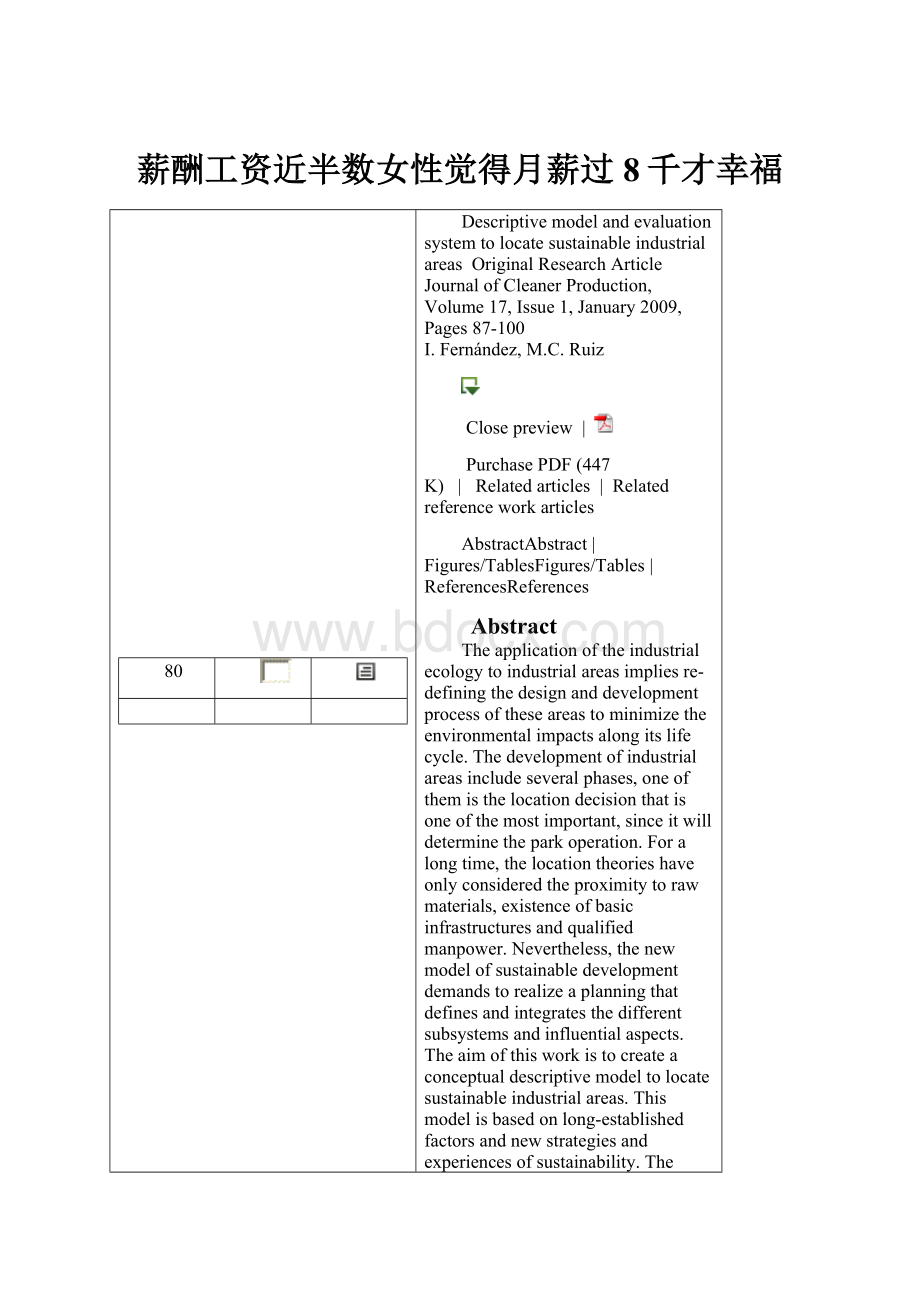薪酬工资近半数女性觉得月薪过8千才幸福.docx
《薪酬工资近半数女性觉得月薪过8千才幸福.docx》由会员分享,可在线阅读,更多相关《薪酬工资近半数女性觉得月薪过8千才幸福.docx(13页珍藏版)》请在冰豆网上搜索。

薪酬工资近半数女性觉得月薪过8千才幸福
80
Descriptivemodelandevaluationsystemtolocatesustainableindustrialareas OriginalResearchArticle
JournalofCleanerProduction,Volume17,Issue1,January2009,Pages87-100
I.Fernández,M.C.Ruiz
Closepreview |
PurchasePDF(447K) | Relatedarticles | Relatedreferenceworkarticles
AbstractAbstract|Figures/TablesFigures/Tables|ReferencesReferences
Abstract
Theapplicationoftheindustrialecologytoindustrialareasimpliesre-definingthedesignanddevelopmentprocessoftheseareastominimizetheenvironmentalimpactsalongitslifecycle.Thedevelopmentofindustrialareasincludeseveralphases,oneofthemisthelocationdecisionthatisoneofthemostimportant,sinceitwilldeterminetheparkoperation.Foralongtime,thelocationtheorieshaveonlyconsideredtheproximitytorawmaterials,existenceofbasicinfrastructuresandqualifiedmanpower.Nevertheless,thenewmodelofsustainabledevelopmentdemandstorealizeaplanningthatdefinesandintegratesthedifferentsubsystemsandinfluentialaspects.Theaimofthisworkistocreateaconceptualdescriptivemodeltolocatesustainableindustrialareas.Thismodelisbasedonlong-establishedfactorsandnewstrategiesandexperiencesofsustainability.Thesecondstepistheestablishmentofadiffuseevaluationsystemthatdeterminesthefulfilmentofdefinedsustainablecriteria.Thismodelmakestheplanningprocessforthedecision-makerseasierthroughasystemthatconsidersmultiplecriteriathatconvergeinordertogetthebalanceofindustrialactivitieswiththeenvironment.
ArticleOutline
1.Introduction
2.TheAnalyticHierarchyProcess(AHP)
3.Locationmodel
3.1.Hierarchicalstructuring
3.1.1.Phase1:
geographicareaselection
3.1.2.Phase2:
evaluationandselectionofsuitableareas
3.1.3.Phase3:
evaluationofspecificzones
3.2.Evaluationfunctionsandweighting
3.2.1.Phase1:
geographicareaselection
3.2.2.Phase2:
evaluationandselectionofsuitableareas
3.2.3.Phase3:
evaluationofspecificzones
4.Conclusions
References
81
Voluntaryrelationshipsamongmobilenetworkoperatorsandmobilevirtualnetworkoperators:
Aneconomicexplanation OriginalResearchArticle
InformationEconomicsandPolicy,Volume21,Issue1,February2009,Pages72-84
AniruddhaBanerjee,ChristianM.Dippon
Closepreview |
PurchasePDF(250K) | Relatedarticles | Relatedreferenceworkarticles
AbstractAbstract|Figures/TablesFigures/Tables|ReferencesReferences
Abstract
Mobilevirtualnetworkoperators(MVNOs)donotholdspectrumlicensesandownlittleornonetworkinfrastructure.Rather,theyresellmobileservicesbypurchasingairtimeatwholesaleratesfrommobilenetworkoperators(MNOs).Unlikeordinaryresellers,MVNOsrelyonbrandappealandreputationacquiredinotherbusinessestosellmobileservices(oftenbundledwithotherproducts).SignificantworldwidegrowthinvoluntaryMNO–MVNOpartnerships,withoutinterventionfrompublicpoliciesthatmandateMVNOaccesstoMNOnetworks,raisesmanyinterestingissues.SinceMNOsthatsellwholesaleservicestoMVNOspotentiallyforfeitsalesindownstreamretailmarkets,voluntaryrelationshipsareplausibleonlyifMVNOsaddvaluebywideningand/ordeepeningMNO-servedmarkets.Thispaperprovidessufficientconditionsforprofit-maximizingMNOsandMVNOstoformvoluntarystrategicpartnershipsbasedonresale,productdifferentiation,andrebranding.Thetwokeyfactorsare
(1)valueoftheMVNO’sbrandreputationand
(2)wholesalediscountatwhichtheMNOoffersservicetotheMVNO.
ArticleOutline
1.Introduction
2.EconomicmodeloftheMNO–MVNOrelationship
2.1.Incentivesfordiscriminationandsabotage:
reviewofrelatedliterature
2.2.TheoreticalmodeloftheMNO–MVNOrelationship
2.2.1.Profitmaximizationwithhomogeneousretailserviceonly
2.2.2.Profitmaximizationwithwholesalediscountandtrade-offinsaleofhomogeneousretailandwholesaleservices
2.2.3.ThecomparativeretailpriceandprofitperformanceoftheMNOwithandwithouttheMVNO
2.2.4.Profitmaximizationwithdifferentiatedretailservices
2.2.5.Profitmaximizationwithwholesalediscountandtrade-offinsaleofdifferentiatedretailandwholesaleservices
2.2.6.ComparativeprofitperformanceofMNOwithandwithoutMVNO
2.2.7.Practicalimplications
3.Conclusion
Acknowledgements
References
82
Modellinginput–outputworkloadcontrolfordynamiccapacityplanninginproductionplanningsystems OriginalResearchArticle
InternationalJournalofProductionEconomics,Volume68,Issue1,30October2000,Pages73-93
BrianG.Kingsman
Closepreview |
PurchasePDF(310K) | Relatedarticles | Relatedreferenceworkarticles
AbstractAbstract
Abstract
Workloadcontrolhasbeendescribedasoneofthenewproductionplanningandcontrolconceptsavailableforpracticaloperations.Themainprinciplehasbeendefinedbyastocontrolthelengthsofthequeuesinfrontofworkstationsontheshopfloor.Ifthesequeuesaretobekeptshort,thenwaitingtimesandhenceoverallmanufacturingleadtimeswillbecontrolled.Therearefourlevelsatwhichthiscontrolofqueuescanbeattempted;prioritydispatchinglevel,jobreleaselevel,jobacceptanceandjobentrylevel.Thefirstoftheseisarelativelyweakmechanismforthecontrolofqueuesifusedalone.Astrongerinstrument,controlledjobrelease,entailsmaintaininga‘pool’ofunreleasedjobsintheproductionplanner'soffice,whichareonlyreleasedontotheshopfloorifdoingsowouldnotcausetheplannedqueuestoexceedsomepredeterminednorms.Themainaimofworkloadcontrol,forthosewhoadvocateitsuseasajobreleasemethod,hasbeendefinedastocontrolthelengthsofthequeuesinfrontofworkstationsontheshopfloor.However,thetrueobjectiveistoprocessthejobssoastomeetthepromiseddeliverydateswiththemachineandworkforcecapacitiesandcapabilitiesavailable.Thejobreleasestagecanitselfonlybefullyeffectiveifthequeueofjobsinthepoolisalsocontrolled.Otherwise,jobsmayremaininthepoolfortoolongsomissingtheirpromiseddeliverydates.Thusacomprehensiveworkloadcontrolsystemmustincludethecustomerenquirystage,(thejobentrystage),tocontroltheinputofworktothepoolaswellandplanthecapacitytoprovideinfutureperiodssotheshopfloorqueuesarealsocontrolled.Amethodologyandsystemstodothisatboththejobreleaseandthecustomerenquirystagehavebeenpresentedinpreviouspapers.Thepurposeofthispaperistoprovideatheoryforworkloadcontrolinamathematicalformtoassistinprovidingproceduresforimplementinginputandoutputcontrol.Itenablesdynamiccapacityplanningtobecarriedoutatthecustomerenquiryandorderentrystagesforversatilemanufacturingmake-to-ordercompanies.Thetheoryshowsthatattentionshouldbeconcentratedoncontrollingthedifferencesbetweenthecumulativeinputsandoutputsovertime,andnottheperiodindividualinputsandoutputs.Althoughaimedatmake-to-ordercompanies,thetheoryandproceduresgiveageneralcapacityplanningmethodforotherproductionplanningmethods;forexampledeterminingthemasterproductionscheduleinMRPsystems.
83
Ambiguousspace,ambiguousrights—corporatepowerandsocialcontrolinHongKong OriginalResearchArticle
Cities,Volume14,Issue5,October1997,Pages295-311
AlexanderRCuthbert,KeithGMcKinnell
Closepreview |
PurchasePDF(1741K) | Relatedarticles | Relatedreferenceworkarticles
AbstractAbstract|ReferencesReferences
Abstract
TheprecursortothisarticlewaspublishedunderthetitleofTherighttothecity(Cuthbert,1995).Inthatwork,theinteractionsbetweensurveillance,privateinterestandthepublicdomaininHongKongwereinvestigated.Thepaperarguedthatarealconfusionexistswithregardtothedelineationofsocialspace,asituationunderwrittenbytheprocessesthroughwhichdevelopmentrightsaregrantedtocorporationsand‘bigcapital’asawhole.Inconsequence,theideaofthecitizen'srighttooccupycertainopenspacesinthecityisrapidlybecomingobscuredascorporatespacebecomesconflatedtosocialspace.Theterm‘ambiguousspaces’wascoinedtodescribethissituation.
Below,werefinetheseideasbyexaminingingreaterdetailtheactualmethodsbywhichambiguousspacescomeintobeing.Detailedstudieshavebeenmadetoinvestigatethespecificitiesofthisprocess—howdevelopmentrightsaregranted,whatconditionsareagreeduponandhowdealsarestruck.Fromthiswebuildaclearerpictureofhoweverydaylifeinthe(post)modernworldofHongKonghasbeencircumscribedthroughthediscretionarypowerofthelocalstate,thecorporatestrategieswhichdirecttheformandcontentofsocialspace,andthedeliberatemanipulationoftheplanningsystemtoaccommodateprivatecapital.WhilespecificmechanismsandpracticesareuniquetoHongKong'sdynamicpoliticaleconomy,weexposebelowoneaspectofaphenomenonwhichwewouldargueincreasinglyunderwritesurbanspaceinwesternsocietiesasawhole.
ArticleOutline
•References
84
Gettingpastfirstbase:
GoingallthewaywithCognitiveWorkAnalysis OriginalResearchArticle
AppliedErgonomics,Volume42,Issue2,January2011,Pages358-370
RichC.McIlroy,NevilleA.Stanton
Closepreview |
PurchasePDF(1702K) | Relatedarticles | Relatedreferenceworkarticles
AbstractAbstract|Figures/TablesFigures/Tables|ReferencesReferences
Abstract
ThispaperreportstheapplicationofCognitiveWorkAnaly